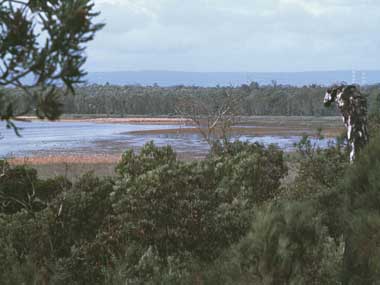Forrestdale Lake is located in the City of Armadale and Thomsons Lake is located in the City of Cockburn both of which lie within the southern Perth metropolitan area, in Western Australia. The lakes are surrounded by medium density urban development and some agricultural land. The sediments of Thomsons Lake are between 30,000 and 40,000 years old, which are the oldest lake sediments discovered in Western Australia to date. Forrestdale and Thomsons Lakes are fresh/brackish, seasonal wetlands, predominately fed by groundwater. Forrestdale Lake usually dries out by mid-summer whereas Thomsons Lake retains water longer and in some years does not dry completely. These lakes are the best remaining examples of brackish, seasonal lakes with extensive fringing sedgeland, typical of the Swan Coastal Plain. Forrestdale and Thomsons Lakes are situated in sand dune systems and contain large areas of open water fringed by rushes and bulrushes, behind which are trees tolerant of seasonal waterlogging. The higher ground around the lakes supports open woodland. The lakes provide important habitat for waterbirds on the Swan Coastal Plain with 72 species of waterbird occurring at the two lakes and 21 of them breeding. Twenty-one species of migratory birds protected by international migratory bird conservation agreements have been recorded at the lakes. Thomsons Lake is one of the last remaining Swan Coastal Plain refuges for the Australasian Bittern, and the only remaining wetland within the Perth metropolitan area where the Marsh Harrier still breeds. Forrestdale Lake was traditionally an important tortoise hunting site for indigenous peoples from as far away as Pinjarra, 50 kilometres to the south. Contemporary uses of the Ramsar site include bird-watching, nature walks, horse riding and general recreation.
Forrestdale Thomsons

Government evidence of impact of climate change:
-
Australian Government, Forrestdale Thomsons Ramsar Site, Ecological Character Description
Driver (primary direct) Climate Change Water Supply Urban Land Use high water levels extended dry periods elevated nutrients pollutants invasive plants Stressor (secondary direct; driver) Loss of shallow water habitats for waders domain shift clear; macrophyte dominated to turbid; phytoplankton dominated insufficient water for fauna to complete life cycles Ecological Effect Loss of deeper water for ducks Loss of biodiversity fiora fauna Attribute (Component) Migratory waders Aquatic (invertebrates) Black swans Plant communities Diving ducks Figure E2 Driver stressor model for Forrestdale and Thomsons Lakes showing drivers; stressors; ecological effects and the attribute component affected.
However; if the climate becomes wetter again; this could lead to a sharp increase in nutrient enrichment and issues with odours; toxic algae and midges.
The four aspects of climate that most directly affect wetland ecology are rainfall; temperature; evaporation and wind.
Fire Unplanned fire is a significant threat to the natural values of the lakes.
Major changes include Maximum water depths at both lakes are substantially lower; the period of inundation substantially less; and annual drying is occurring earlier than at any time in the past.
Seasonal drying is linked to increased productivity of aquatic invertebrates; which should result in large numbers of waterbirds (Crome 1988).
Impacts of declining water levels include Earlier drying has resulted in the encroachment of vegetation (predominantly Typha orientalis) onto the lake bed; subsequently decreasing the amount of mudflats available for wading birds.
The premature drying of Thomsons Lake has resulted in cygnets; which have not matured to a stage where they can fly; being trapped inside the predator proof fence whilst trying to find an alternative water source.
The lakes are now drying for increasingly longer periods of time and the duration of time that water is present in Forrestdale and Thomsons Lakes is currently less than any time in the past.
Such long periods of drying exceed the limits of acceptable change and are resulting in deleterious changes to the condition of the lakes (see Section 5).
Such frequent drying prior to December exceeds the limits of acceptable change and is resulting in deleterious changes to the condition of the lakes (see Section 5).
The adverse impacts of an annual drying regime and reduced water depth include Reduced amount of time for flora and fauna dependent on water e.g. aquatic plants; macroinvertebrates and waterbirds; to complete their lifecycle.
An increase in frequency and duration of prolonged drying phases may result in a loss of resilience in the invertebrate biota. a 7.4 Waterbirds The number of waterbirds and number of species recorded at Forrestdale and Thomsons Lakes have been variable; but overall have declined in recent years.
A summary of the major changes to the ecological character of the Forrestdale and Thomsons Lakes Ramsar site since the time of listing; which are identified in sections 7.1 7.6; includes Maximum water depths at both lakes are substantially lower; the period of inundation substantially less; and annual drying is occurring earlier than at any time in the past.
The unusually low water depth and early drying of the lake was probably due to extremely low rainfall during winter and spring and subsequently low groundwater recharge.


